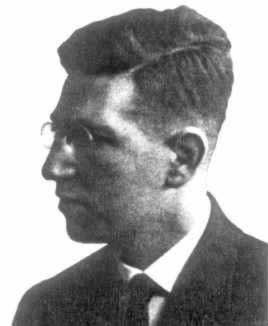
Otto Schreier
 المؤلف:
B Chandler and W Magnus
المؤلف:
B Chandler and W Magnus
 المصدر:
The History of Combinatorial Group Theory: A Case Study in the History of Ideas
المصدر:
The History of Combinatorial Group Theory: A Case Study in the History of Ideas
 الجزء والصفحة:
...
الجزء والصفحة:
...
 26-9-2017
26-9-2017
 781
781
Born: 3 March 1901 in Vienna, Austria
Died: 2 June 1929 in Hamburg, Germany

Otto Schreier graduated from high school in Vienna in July 1919. He entered the University of Vienna in 1920 to study mathematics. At Vienna he attended lecture courses by Wirtinger, Furtwängler, Hahn, Reidemeister, Rella, Lense and Vietoris. His doctorate, supervised by Furtwängler, was awarded for a thesisÜber die Erweiterung von Gruppen (On the extension of groups) on 8 November 1923.
After receiving his doctorate, Schreier went to Hamburg and worked until his death at the Mathematische Seminar. He was appointed to the post of assistant in the summer 1925 and worked for his habilitation. In fact Schreier gave lecture courses, at the request of the mathematical faculty, before completing his habilitation. This was formally awarded on 1 December 1926 for a thesis entitled Die Untergruppen der freien Gruppe (The subgroups of free groups).
Schreier was offered a professorship at the University of Rostock in 1928 and decided to accept the position but he preferred to wait until the summer of 1929 before taking up the post. During the beginning of the 1928/29 session Schreier lectured on function theory giving parallel courses in Hamburg and Rostock. However, around Christmas of 1928, an illness which had been steadily worsening prevented him from continuing with his lectures. He died five months later at the age of 28 of a 'general sepsis'. The sulpha drugs discovered a few years later probably would have saved his life and therefore would have greatly changed the development of combinatorial group theory.
Schreier was much influenced by Furtwängler and Reidemeister. His first paper in 1924 gave a simple algebraic proof of a theorem on knot groups, which generalised a theorem given by Dehn 10 years earlier. He may have been directed towards the main theorem, which proves that certain torus knots were not isomorphic to their mirror images, by Reidemeister. These knots gave rise to groups which were free products with an amalgamated subgroup and Schreier studied this property in detail in a 1927 paper.
Schreier will be best remembered for his work on subgroups of free groups which he studied in his habilitation thesis. He published the results in 1927 in the paper Die Untergruppen der freien Gruppe which is described in [1] as
... one of the most important papers ever published on combinatorial group theory. It took a long time for all its aspects to become effective, and it contains much more than the title indicates.
In January 1926 Schreier attended a lecture given by Reidemeister in Hamburg on finding presentations for normal subgroups of finitely presented groups. Reidemeister published his method later in 1926. Schreier, who took a more algebraic approach compared to Reidemeister's geometrical approach, was able to extend Reidemeister's method to arbitrary subgroups and, by cleverly choosing generators for the subgroup, was able to greatly simplify the presentation obtained. Schreier published his method in his 1927 paper Die Untergruppen der freien Gruppe.
Other work of Schreier is described in [1] as follows.
... Schreier made important contributions to other parts of group theory. The classical Lie groups ... can be considered as topological spaces. Schreier (1927) showed that the fundamental group of such a space is always abelian. Schreier (1928) found an important refinement of the fundamental Jordan-Hölder theorem, 39 years after the publication of Hölder's paper. It is rare that such a widely used and basic theorem can be deepened after such a long time. (In this case, something even more unusual happened. Zassenhaus (1934) discovered a second improvement of the theorem.)
Articles:
- B Chandler and W Magnus, The History of Combinatorial Group Theory: A Case Study in the History of Ideas (New York - Heidelberg - Berlin, 1982), 91-98.
- Otto Schreier (Obituary), Abhandlungen aus dem Mathematischen Seminar der hamburgischen Universität 7 Band (1929), after page 106.
 الاكثر قراءة في 1900to1904
الاكثر قراءة في 1900to1904
 اخر الاخبار
اخر الاخبار
اخبار العتبة العباسية المقدسة


